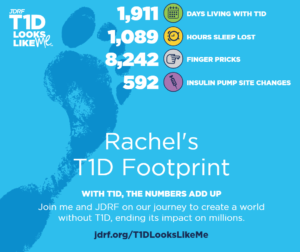Diabetes Awareness Month: 8,200 Pricks
I’m wearing blue today, as I do many Fridays during the year. People must really think that I like the color blue. While I do like blue, the color means a bit more to me.
November is Diabetes Awareness Month… it’s a global awareness month. November isn’t really a month for people with diabetes, because we’re well aware of the realities of this disease each and every day.
November is for you, dear friend without diabetes. It’s a month specially set aside for you to be aware of diabetes. To learn about the realities people like me face every day. To learn the truths about the different types of diabetes. To change your mind, your language and your attitude about the word “diabetes.”
The two most prominent diabetes organizations are working hard this month to help spread awareness and enable advocates.
T1D Looks Like Me
What does life with type 1 diabetes look like? Here’s a quick snapshot of my diabetes footprint… and I haven’t live with type 1 for very long!
8,200+ pricks in my time span with diabetes. Intentionally bleeding 8,200+ times, so that I can do my best to control my diabetes. 592 site changes, plus the 600 or so injections prior to starting OmniPod, plus the roughly 225 CGM sensor changes adds up to sticking myself with some form of needle more than 1,400 times… intentionally.
I don’t do this for fun. If okra water, cinnamon or cucumbers cured this, I’d do it. I really don’t like needles. People say that numbers don’t lie, these numbers are evidence of the constancy of this disease. When I was first diagnosed and in the hospital, only those really close to me understood it, primarily because they heard “this is serious,” straight from the mouth of a doctor. Others said, “Oh, it’s only diabetes” and moved on.
Make your own footprint at jdrf.org/T1DLooksLikeMe.
This is Diabetes…
These are the realities that people with diabetes deal with. The misconceptions. It’s only diabetes. All the types of diabetes are serious. The American Diabetes Association is shedding light on what diabetes looks like as well. Allow me to quote them for a second…
Did you know that 1 in 11 Americans today has diabetes? Despite its prevalence, diabetes is an invisible disease. It affects men and women, people young and old, and people of all races, shapes and sizes. Often there are no outward signs from the 29 million Americans who fight this chronic illness every day. That’s why there is a critical need to foster awareness and education while breaking down stereotypes, myths and misunderstandings about this growing public health crisis that affects so many of us.
You can’t see the 8,200+ pricks and 1,400+ on my body every day, if you’re lucky you might catch a glimpse of my pod or see a few spots on my fingertips. If you could see all of it, you would know that it’s serious. But all in all, diabetes hides just under the surface, affecting the person with it and their families.
Visit diabetes.org/adm to learn more about the ADA’s campaign.
So, what do you want Rachel?
You may be thinking, “Okay Rachel, I get it having diabetes sucks. But what do you want from me?”
The goal of Diabetes Awareness Month is the same as all awareness months… Mission Number One is to increase not only awareness of the disease but understanding. People with chronic health conditions often aren’t talking about them to get pity, they want to be understood. That’s what I want above all by choosing to blog about diabetes, I want you to understand me, and the 29 million other Americans and even more world wide who live with diabetes at least a little better.
After you understand, I would ask you to act and react better. Change your behavior. Don’t laugh at the stupid diabetes joke. Correct people when they spread myths about diabetes. Don’t freak out when someone checks their blood sugar or takes a shot around you (and don’t ask them to do that in the bathroom, it’s gross). Don’t ask, “Should you be eating that?” and definitely don’t tell someone with diabetes what they can’t do. Do ask questions when you don’t understand something.
And of course, donating to one of the many excellent diabetes causes would be awesome, whether you’re supporting cure research, better treatments, assistance programs for people to get life-saving medications or scholarships to send kids with diabetes to camps, you can help others.
I’m pretty sure everyone knows someone who is impacted by diabetes.

Thank you for the reminder.
This item has been referred to the TUDiabetes Blog page for the week of October 31, 2016